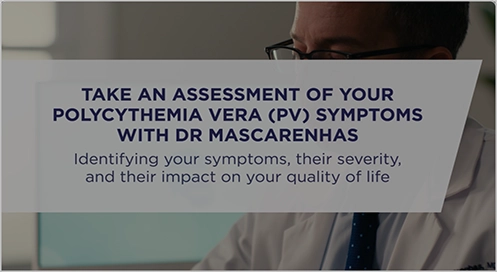


Identifying
Polycythemia Vera (PV)
Symptoms
VIEW TRANSCRIPT 

Hi. I’m John Mascarenhas, a Professor of Medicine and the Director of the Center of Excellence for Blood Cancers and Myeloid Disorders.
You may have been diagnosed with polycythemia vera, or PV. Then it’s important to know that the majority of patients living with PV have symptoms, but these symptoms sometimes go unrecognized because they are often associated with getting older or may even slowly become worse over time.
This can cause confusion and lead you to think that these symptoms are your new normal, but they are not. And these symptoms may be due to your PV.
Also, consider that new or worsening symptoms could be a sign that the disease is progressing, even if your blood counts are well controlled.
This is why it’s important to understand your symptoms and make sure you are communicating them with your healthcare professional. When these symptoms are caught early on, they may be easier to manage.
It can all seem a little confusing.
So, let’s remove the confusion and replace it with confidence by helping you learn more about the most common symptoms of PV, how to spot them, where they come from, and how to communicate with your healthcare professional.
There are three important words you need to understand to know how your PV is affecting you:
Symptom: Which symptoms are you experiencing?
Severity: How severe is your symptom? And,
Impact on quality of life: How is it affecting your daily life?
When we go over the PV symptoms mentioned in this video, you should first ask yourself, “Do I have any of these symptoms?” Then, “What is the frequency and severity of my symptoms? And are there activities I once enjoyed but am no longer able to do because of my symptoms? And how are these symptoms affecting my quality of life?” This is what you should be sharing with your healthcare professional. This will give your healthcare professional a better picture of how PV is making you feel. And remember, your healthcare professional may be able to help you, but you must tell them about your symptoms.
There are different types of PV symptoms. You may be feeling one or more of these.
Some of the most common PV symptoms are cytokine-related. Cytokines are signaling molecules secreted by blood cells that have an effect on your body.
When you have PV, your cytokine levels are elevated, which causes you to have symptoms.
An example of how cytokines work is when you get sick, say, with a cold, and you feel unwell. It’s the cytokines that activate your own immune response to fight the infection that makes you feel sick. The symptoms of PV are caused by similar cytokines.
Many of these symptoms can be present even if your blood counts are well controlled.
Here are the most common cytokine-driven symptoms to look out for.
The first one is fatigue. In one study, chronic fatigue was reported by 73% of patients with PV. This is not feeling tired from time to time. This is “I don’t have the strength to do what I normally do.” For example, are there activities you once enjoyed but are no longer able to do because you feel too tired?
Experiencing fatigue means missing moments that matter. You may miss out on being with friends; you can’t contribute around the house; and in severe cases, you can’t even get out of bed because of your fatigue.
Shortness of breath is also common. I’ll ask my patients, “Do you get short of breath?” And they’ll say, “No.” I’ll then ask them, “Did you take the stairs to get here?” and they’ll often say, “No. I took the elevator.” Why? “Because I get out of breath when I climb stairs.”
If you are feeling fatigue 2 or 3 times per week, this may be your PV and you should tell your healthcare professional the severity of the fatigue.
In a different study, 24% of all PV patients reported an inactive lifestyle.
Maybe your favorite chair has become more of a home base for you. Staying home has become your new normal. Other people may have noticed too and mentioned it to you.
If you are noticing your inactivity, it’s very likely that it’s your PV. Tell your healthcare professional. Mention the things you are no longer able to do that you could do three or six months ago.
Let’s now talk about night sweats. It is normal to sweat at night if the room temperature is too hot or if you have too many blankets on. But if it’s happening under normal conditions, it may be a cause for concern.
The number of nights each week you wake up with night sweats is also something you should be keeping track of.
You might find yourself waking up during the night with damp or even soaked clothes or sheets.
Are you experiencing night sweats that you weren’t experiencing a month ago? It is very possible that this is due to your PV, and you should mention it to your healthcare professional.
Another symptom associated with PV is itchiness. And everybody gets itchy and everybody scratches. But itchiness due to PV is different.
If you are itching every couple of minutes after you shower or bathe, get out of a swimming pool, or even after you put on a sweater, there is a good chance that it’s your PV. Tell your healthcare professional how often you are itching and what activities are limited due to itching. This type of itching can be severe—like an itch that can’t be satisfied no matter how much you scratch.
Tell your healthcare professional how many activities you used to do that you just don’t do anymore because of Itching. Also, mention how many activities you have missed because of your itching since your last appointment.
Let’s turn now to another PV symptom: bone pain. PV-related bone pain is different from the kind of joint pain in the arms and legs that you would feel with arthritis. It’s a deep ache throughout your body that you may feel all the time. And sometimes this pain may come and go and sometimes it can be steady.
If you are feeling bone pain more than two times a week and it’s keeping you from doing activities, or if you are experiencing other symptoms such as unplanned weight loss or fever over 100 degrees, you should report these to your healthcare professional.
Another common condition related to PV is hyperviscosity. Put simply, your blood is flowing slower in the smaller blood vessels due to the overproduction of red blood cells. Elevated blood counts may be putting you at risk for thrombosis.
Thrombosis is when blood clots form in your blood vessels, which can cause further complications. So, if you are experiencing one of these symptoms, which may be due to hyperviscosity, such as headaches or visual changes, it’s important that you communicate them to your healthcare professional as soon as possible.
Now, let’s talk about concentration problems. I think everyone has experienced walking into a room, forgetting why they’re there, forgetting words, dates, or having brain fog. These are common symptoms of PV, and like other PV symptoms, can be confused for something that happens as you get older—or some other problem entirely.
So it’s important to keep track of how long it lasts and how often it happens. Is it once a week? Two or more times a week? Also, let your healthcare professional know how it’s affected you at your job, at school, or at home, and what you’ve been missing out on doing in your life because of it. This could be a sign that your blood counts are elevated and should be managed as soon as possible.
Let’s now turn to PV symptoms related to an enlarged spleen. With PV, the bone marrow produces too many red blood cells, white blood cells, and platelets. The spleen works overtime to filter the increased number of blood cells but also becomes a source of blood cell production. As a result, the spleen gets larger. And since the spleen is near the stomach, you may feel the following symptoms.
You may find that you can’t eat a full meal because you’re experiencing a feeling of fullness. This could be a recent feeling or maybe it’s been slowly sneaking up on you. You might even feel pain or pressure under the left rib. Remember, eating shouldn’t be painful and it could be a sign that something is not right.
How often are you feeling this way when eating? More than 2 times a week? At every meal? It’s important that you mention this to your healthcare professional.
Another related symptom of an enlarged spleen is abdominal swelling and discomfort. An enlarged spleen because of PV can also affect your quality of sleep and your appearance. Maybe your belly looks a little bulgy and different than it used to. Maybe you’re trying to hide it by wearing looser-fitting clothes. You may even find that your seat belt is painful to put on. These types of things could have happened so slowly that now you think of them as normal and part of your daily life.
But take a step back. Tell your healthcare professional when and how often you feel abdominal discomfort, such as after you eat or when laying down. Your healthcare team needs to know this and may need to examine your spleen size.
Remember, there are three important words you need to understand to know how your PV is affecting you:
Symptom
Severity, and
Impact on quality of life
It’s important to know which symptoms you are feeling and then write them down so that you’ll be able to talk about them with your healthcare professional.
An easy way to keep track of your symptoms is by using a tool called the PV Symptom Assessment Form. You can use this tool to note each symptom and include details, such as the severity of the symptom; how the symptom affects your life; and whether the symptom is stopping you from doing normal, everyday things such as work, sleep, or exercise. The PV Symptom Assessment Form will help give your healthcare professional a better idea of which PV symptoms you’re experiencing so they can develop an effective treatment plan for you.
You can download it from voicesofmpn.com or use the QR code on the screen, which will take you directly to the PV Symptom Assessment Form.
You are the key to noticing your PV symptoms so that they can be managed. So be honest with yourself and your healthcare professional. That means talking about all of your symptoms because any one of them can affect your quality of life. If you’re having any of these symptoms, it is important to tell your healthcare professional, as this could mean that your disease is progressing—no matter your blood count or the medication you’re taking. Your healthcare professional may recommend treatments that can help you, so don’t wait.
I invite you to watch the next video where I will go through the PV Symptom Assessment Form with you, like I do with my patients, so you can think about it and discuss your PV symptoms with your healthcare professional. When identified early, they can be better managed.
Thank you for watching this video.
Watch This Video to Find Out More About PV Symptoms
Watch as Dr John Mascarenhas guides you through identifying PV symptoms to help you talk about their impact on your daily life with your Healthcare Professional.


Keep Track of Your PV Symptoms
Take a real-time assessment with Dr Mascarenhas as he walks through how to use the PV Symptom Assessment Form


Dr John Mascarenhas, MD
Cancer (Oncology),
Hematology-Oncology
MPN Expert


Keep Track of Your PV Symptoms
Take a real-time assessment with Dr Mascarenhas as he walks through how to use the PV Symptom Assessment Form
Download the PV Symptom Assessment Form
Get started assessing your PV symptoms, their severity, and their impact on your quality of life



